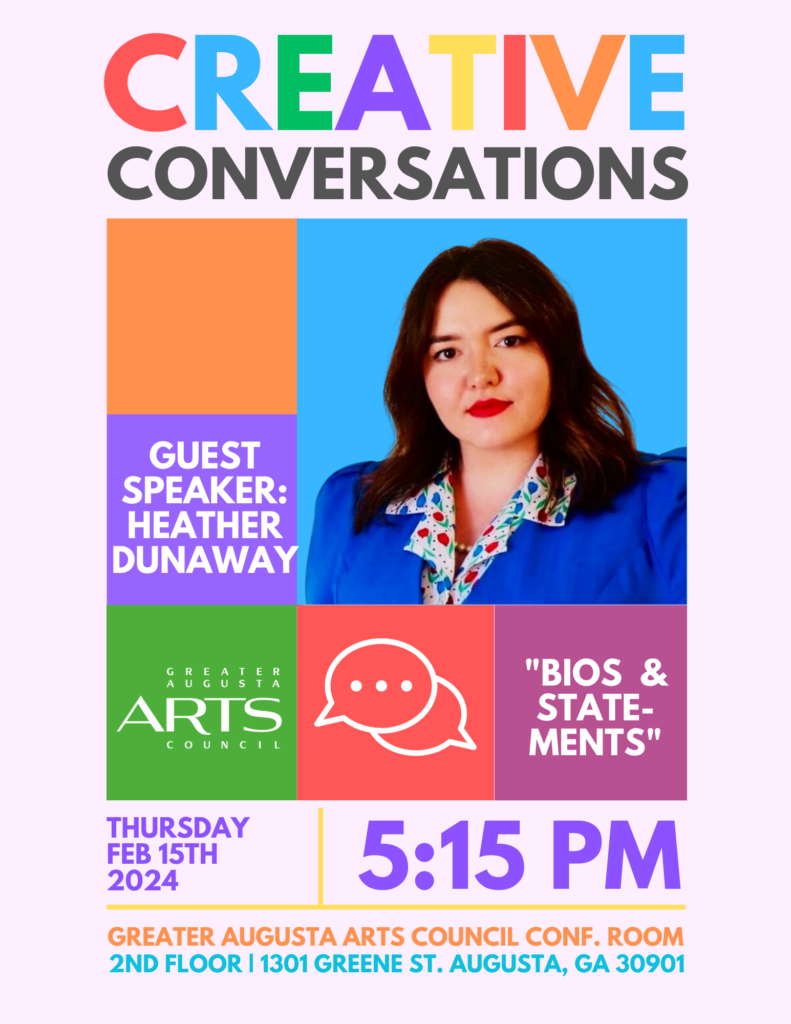So, I’m over here in my office at the Arts Council getting together my PowerPoint presentation for my upcoming Creative Conversation talk on writing artist biographies and statements. This is a subject I’ve always felt that our local artists could use a little basics course in. As someone who has written them for herself, proof read over my friends, and combed through them in applications I get for our two galleries, I can say with certainty it is necessary to know how to write them well. Or, at least, well enough.
In my presentation I will give tips on what to include, a standard outline for biographies, and some examples, but I am most excited to do some in person critiques with the group. Feedback is so important. Not only will the creatives who attend get some much needed constructive criticism of their own writings, but they will get the chance to stretch those critique muscles themselves. I always found critiques in college useful as it taught me how to look more critically at my own work. Stepping back and taking a break before analyzing your writing or work before hitting that submit button is a game changer.
I think one of the most common faux pas I see in artist bios is everyone pointing out that they have been “making art their whole life.” It’s a mistake I made when I first started writing my biographies, until I had someone point out to me that what I made when I was six is not the same thing as what I am making as an adult. Six-year-old me could not compete with thirty-three-year-old me when it comes to drawing a cat. I’d wipe the floor with her.

If you want people to take your adult work seriously, you yourself can’t take the work of the artistically inclined six-year-old version of yourself seriously. You don’t show that work in your portfolio, so why include it in your bio? Now, if you were writing an autobiography about your life and love of art, sure, include what little you really loved about being creative and how you evolved over the years. If you are applying to a show, it’s not something that stands out to curators. Unless its relevant to what you making, they really only want to know what you are up to now.

I think one of the main things to consider is the length of your bio or statement and where you plan to share it. If it’s going up on a website, social media, in a gallery or the back of your album label, it’s best kept short, sweet and to the point. No need for filler and fluff. Just be honest about you and your work. Usually, it’s also expected to be written in third person perspective. That way, whoever you are sharing it with can quickly add it to a press release without much editing.
Don’t forget to have it proofread before sending it off!
This is something I am trying myself to be better at in 2024. If you yourself are bad at proofreading, ask a friend or someone you trust to read through it for you. Or, read it outload to yourself – this is what I usually do.
Artist Statements, on the other hand, are less about your life and more about your art. It’s a first-person account of something you have created, along with what, why, how, when, who, where, etc. behind it.
Unlike a bio (which is usually 3-6 paragraphs) These are typically just one paragraph. The context of where the statement is displayed do play a big part. If it’s in an art museum or featured in a big article, you can get away with longer. Most times it’s put alongside your artwork or used as a quote, etc. In my Creative Conversation talk we are going to read over some really cool statements. It’s important to know how to talk about your work. You want to be able to have conversations with potential patrons / fans about something that is piquing their interest in your work. They want to see the art from the artists perspective. It will change the way they experience it.
If you want to come to my Creative Conversation, just visit: https://bit.ly/CreativeConversationsSignUp
That’s the word,
-Heather